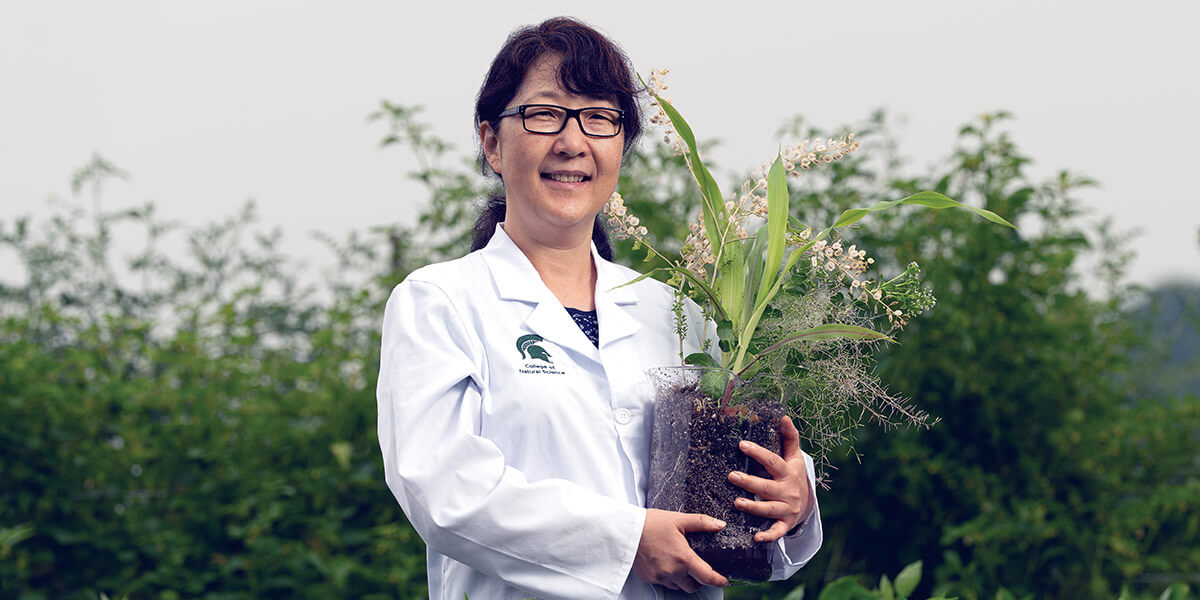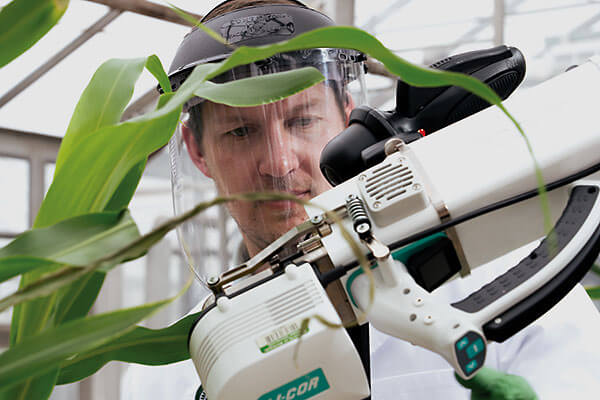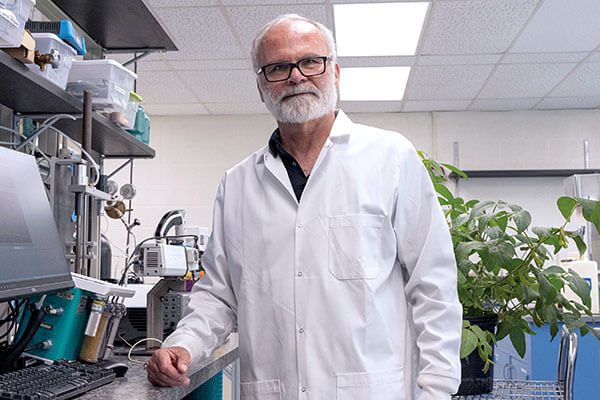Seeds of Hope
Plant researchers are racing to build climate-resilient crops before global food systems reach a breaking point
By Bethany Mauger

College of Natural Science plant researchers are racing to build climate-resilient crops before global food systems reach a breaking point.
Global food production is at a crossroads. Rising temperatures, droughts and extreme weather are making it harder for farmers to grow wheat, rice, corn and soybeans. Growing seasons have shifted. Erratic rain is lowering crop yields. And in some parts of the world, water is scarce.
Michigan State University stands ready to meet this crisis head-on. Many College of Natural Science plant researchers are dedicating their careers to making sure our planet has enough food for the nearly 10 billion people it is expected to house by 2050. That's an increase of about 3 billion from the 2010 population.
Faculty are scrutinizing plant processes like photosynthesis, looking for ways to make them resistant to heat, drought and pathogens. They're creating natural fungicides and biostimulants as a stopgap to keep crops growing as new varieties are engineered.
Eventually, this foundational research could lead to climate-resilient crops to feed an ever-growing population, even in extreme weather.
Analyzing photosynthesis
Most high school biology students learn that plants use photosynthesis to turn light into energy. Associate Professor Berkley Walker said that's only scratching the surface.
Plants use that energy to capture carbon dioxide, or CO2, from the atmosphere and convert it into sugars. These sugars are the building blocks plants use to grow. From the time a seed sprouts out of the ground, a plant uses CO2 to make every compound it needs for life.
"That fundamental process of grabbing CO2 out of the atmosphere sits at the crux of how our Earth is impacted by changing CO2 and temperatures," Walker said.

In some respects, giving plants more CO2 is like giving a person more hamburgers. If they eat more, they'll get bigger. The caveat is temperatures are also increasing. When that happens, photosynthesis gets sloppy.
Occasionally, instead of grabbing carbon dioxide, a plant grabs oxygen instead. The plant is then stuck dealing with accidental oxygen molecules, a process called photorespiration.
Under normal circumstances, photorespiration happens about once out of every five reactions in which a plant is supposed to grab CO2. As temperatures heat up, plants accidentally grab oxygen even more often. The result is wasted energy, and photosynthesis is less efficient.
"That's one big thing my lab looks at," Walker said. "It's this interplay between, what is increasing CO2 going to do? What are increasing temperatures going to do? And how does that affect the total amount of carbon in plants, and what do they do with that carbon once they've turned it into sugars?"
Simulating future conditions
To study the interplay between increasing CO2 and rising temperatures, Walker uses the plant science equivalent of a lab rat — Arabidopsis thaliana, or mouse-eared cress. The plant's six-week life cycle makes it the perfect specimen for quick study results.
Walker's lab grows it in chambers that replicate high CO2, high temperature conditions. They use a laser to measure the leaf's CO2 composition before and after, giving them a snapshot of how the plant moves carbon from outside to inside the leaf.
Inside the MSU Research Greenhouse Complex, Walker's lab creates programmable droughts. Each pot has its own soil moisture sensor and drip irrigation system. This gives researchers an accurate read on what happens to plants with limited water, another stressful condition that's becoming more common.
Laying the foundation for future work
Walker's science is several steps away from translating directly to food. What's true for Arabidopsis might not be true for corn or soybeans, and lab and greenhouse conditions don't always translate to growing plants outside.
His goal is to eventually transition to studying crop species. Turning that goal into reality will take grant funding and potentially years of work to study plants through multiple growing seasons.
"The climate is changing rapidly and unexpectedly, and we want to be able to have solutions ready to go." Seung Yon (Sue) Rhee
Director, Plant Resilience Institute
Even then, it can take years to engineer new varieties of seeds through breeding and biotechnology. That's where Seung Yon (Sue) Rhee's lab comes in.
Rhee is the Director of MSU's Plant Resilience Institute, or the PRI, as well as an MSU Foundation Professor of Biochemistry and Molecular Biology, Plant Biology, and Plant, Soil and Microbial Sciences. Recently, Rhee was awarded a National Science Foundation Global Centers Award to create the Center for Sustainable Plant Innovation and Resilience through International Teamwork, or C-SPIRIT. This initiative aims to unite interdisciplinary experts worldwide explore sustainable solutions for agriculture — not just in the future, but right now.
"We want to find faster solutions that can go out to the farmers," Rhee said. "The climate is changing rapidly and unexpectedly, and we want to be able to have solutions ready to go. This is a short-term solution while new varieties are coming down the pipeline."
'Field-to-lab'
Rhee knows model plants are good proxies for crops, but not perfect. Sometimes, lab discoveries don't translate to farming breakthroughs because the environmental variables are hard to control.
To solve this problem, Rhee plans to flip this process on its head.
"We want to do field experiments first and understand what the interesting problems are," Rhee said. "Then we'll bring it back to the lab and figure out the mechanisms."
Much like a medical researcher uses clinical trials to determine a treatment's success, Rhee will experiment with techniques directly in the field. She'll partner with farmers to study environmental effects in real time instead of simulating them in a lab.
Rhee wants to understand how plants handle stressors such as heat, drought and fungal outbreaks. Once she identifies resiliency traits, her lab will identify the molecular players responsible and engineer them to make plants more resilient to extreme weather conditions.
The lab will do this through multiple approaches. One approach is to study crop plants such as corn and sorghum, examining how they change in drought and heat and whether researchers can manipulate plant systems. Another approach is to study a desert plant known as shrubby honeysweet that thrives in hot, arid environments like California's Death Valley.
Studying chemicals that protect plants
A lesser-known plant chemical called isoprene can protect plants from stressors such as heat and pests. The catch is, it's bad for the Earth's ozone layer. Thomas D. Sharkey, Emeritus University Distinguished Professor in the Department of Biochemistry and Molecular Biology and the MSU-Department of Energy Plant Research Laboratory, or PRL, and a member of the PRI, has devoted much of his career to understanding this chemical and weighing the costs and benefits.

Isoprene is unusual because some plants produce it while others don't. Still others produce isoprene only under stress — what Sharkey calls having its cake and eating it too. Plants such as oak trees churn out isoprene on hot days. Isoprene is also a handy insect repellant. The chemical makes plants indigestible, so insects that dare to take a bite aren't likely to come back for seconds.
Conversely, isoprene is a huge source of hydrocarbons entering the atmosphere — second only to methane emissions. Isoprene interacts with nitrogen oxide compounds found in air pollution produced by coal-fired power plants and internal combustion engines in vehicles. These reactions create ozone, aerosols and other byproducts that are unhealthy for both humans and plants.
"We have to ask, should we put isoprene into plants because it helps the plants resist various stresses, or should we take it out because it's causing the atmosphere to get dirtier?" Sharkey said.
If nothing changes
Growing crops is a visceral need. Not only is it a matter of basic survival, but it's also a huge part of the global economy. Crop production has already declined over the last 60 years, and climate change will continue to make it worse, Rhee said.
Farmers may also have to reimagine where food crops are grown. Some climate models already show the wheat belt moving out of the United States and into Canada, Walker said.
"Looking toward future conditions, I think the plants will be just fine," Walker said. "But as far as having the plants do what we want them to do, where we want them to do that — that may not be the case."
